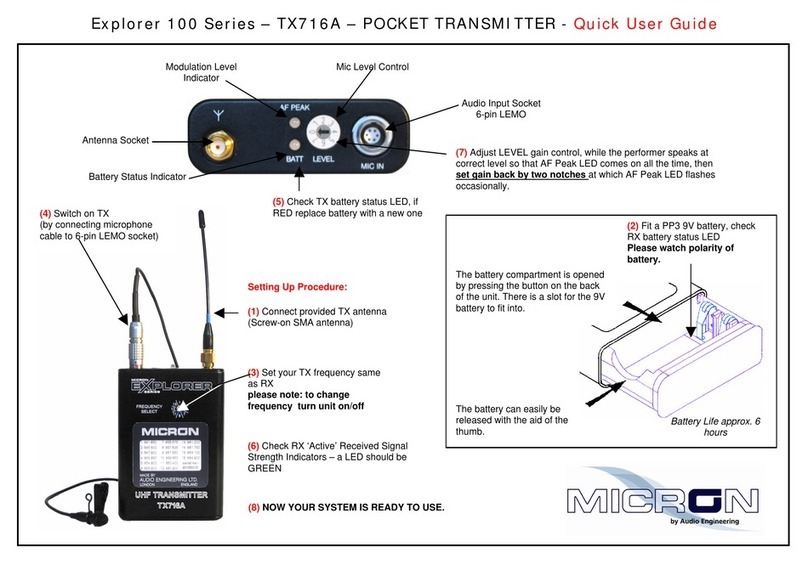of the model
3. Wait at least 5 seconds without touching any controls
4. Tap out the morse code ‘SOS’ on the bind button (… --- …)
dots (…) will be a quick press of the button and must be less than 0.7 seconds in duration
dashes (---) must be greater than 0.7 seconds and shorter than 5 seconds – 2 seconds is a reliable
time
the time between each dot or dash must be less than 5 seconds
5. If the SOS pattern is recognised, the Rx LED will display a repeating single-flash (1-flash pause and
repeat)
6. If you do not get the 1-flash, go back to step 3 and repeat the SOS
7. Switch the Rx off at any time to abort
To make changes to receiver settings:
One programming change requires up to five choices to be made. These are called 'levels' and each has
several options. They are documented in the programming table for the particular receiver; the Micron web
page description for a receiver contains a link to the programming table for that receiver. Completion of a
programming change exits programming mode and requires the F1/F2 or SOS method to be entered again
for the next change.
You have to remember which level you are changing and the repeating LED flashes display the current option
for that level. It is a good idea to write the programming sequence on a piece of scrap paper and cross off
each digit as it is entered. You always start at level 1. For example, the first choice is the Menu number
(programming group). The first option (1-flash) is for changing 'H' (ESC) outputs, the second (2-flash) is
Menu 2 to change P outputs for servos, 3-flash is for Menu 3 to change P outputs for on/off switching, etc.
Refer to the Programming Table for your receiver to find the number of options and what they change. Each
level is in a separate column, 1 to 5 left to right.
For example, to configure a Deltang Rx6 receiver output P4 to switch on (3.3V) when F1 is pressed (R/C
channel 2 is low), the programming sequence is 3,4,1,2,1, where:
3 = Menu 3
4 = P4
1 = momentary on/off
2 = R/C channel 2
3 = output idle 0V, 3.3V when channel is high (F1 pressed)
The general procedure for entering a programming sequence is, for each level:
rotate the direction knob Rev/CCW and back to centre to increment the Rx LED flash count (called NO
choices in the Deltang documentation); repeat this until the Rx LED is showing the correct flash count
for the programming level
rotate the direction knob Fwd/CW and back to centre to accept the current flash count for the current
level (called a YES choice in Deltang documentation) and move on to the next level in the programming
sequence
When you make a choice with the direction knob (Fwd or Rev), the Rx LED will briefly flash rapidly and then
the LED will:
direction knob Fwd/CW: display the current flash count for the next programming level or light solid
when the end of the programming sequence is reached
direction knob Rev/CCW: display the next flash count for the current level; each programming level
has a maximum flash count after which the flash count returns to 1 with another Rev/CCW movement
of the direction knob
Changes are saved automatically when the Rx LED lights solid at the end of a programming sequence. If a
mistake is made mid way through a sequence, switch the Rx off to abort.
Repeat the above steps for each program function that you wish to alter.
For example, to set the ESC output (the first if the receiver has multiple ESC) to respond to full range
regulator on channel 1 and direction control on channel 3, the programme sequence is 1,1,2,1,3:
Enter programming mode
Rx LED displays 1-flash, direction knob Fwd/CW to accept
























